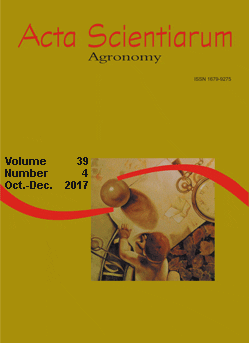<b>Dynamized high dilutions for management of the leafcutter ant <i>Acromyrmex laticeps</i> Emery (Hymenoptera: Formicidae)
Resumo
High dilutions may have different biological effects due to the dynamization method and the dilution order used. The aim of this paper was to evaluate the foraging activity of the leafcutter ant Acromyrmex laticeps subjected to high dilution preparations originating from grinding worker ants and developing dilutions at the following dynamizations: 6, 12, and 30 CH (centesimal Hahnemannian dilution order), 5 LM (fifty millesimal Hahnemannian dilution order) and 35 K (Korsakovian dilution order). The preparations were applied daily for 10 days by spraying them on moving ants on tracks close to the anthill. The evaluations included counting the number of ants transporting vegetable fragments on the tracks before each application, after application, and 20 and 30 days after the first application. The high dilution preparations for the 6 and 30 CH and 35 K treatments reduced the foraging activity of the leafcutter ant A. laticeps after 10 applications. The 30 CH treatment showed a higher reduction in the foraging activity of A. laticeps anthills. Prolonged reduction of the foraging activity of A. laticeps anthills was observed 20 days after the first application with the 35 K and 30 CH treatments.
Downloads
Referências
Adler, U. C., Amarilys, T. C., Adler, M. S., Padula, A. E., Garozzo, E. N., & Galhardi, W. M. P. (2010). Da padronização farmacêutica à pesquisa clínica: 20 anos de experiência com diluições cinquenta-milesimais. Revista de Homeopatia, 73(1/2), 57-67.
Almeida, A. A., Galvão, J. C. C., Casali, V. W. D., Lima, E. R. L., & Miranda, G. (2003). Tratamentos homeopáticos e densidade populacional de Spodoptera frugiperda em milho. Revista Brasileira de Milho e Sorgo, 2(2), 1-8.
Betti, L., Borghini, F., & Nani, D. (2003). Plant models for fundamental research in homeopathy. Homeopathy, 92(2), 129-130.
Boff, P., Giesel, A., & Boff, M. I. C. (2016). No-residual baits and farmer perception to manage leaf-cutting ants. Agroecology and Sustainable Food System, 30(4), 455-465.
Boff, P. (2008). Agricultura saudável: da prevenção de doenças. pragas e parasitas a teraupeutica não residual, Lages, SC: Epagri/Udesc.
Bonato, C. M., & Silva, E. P. (2003). Effect of the homeophatic solution Sulfur on the growth and produtivity of radish. Acta Scientiarum. Agronomy, 25(2), 259-263.
Brasil. (1997). Farmacopéia homeopática brasileira (Parte II). São Paulo, SP: Atheneu.
Camargo, R. S., Forti, L. C., Matos, C. A. O., & Andrade, A. P. P. (2004). Physical resistance as a criterion in the selection of foraging material by Acromyrmex subterraneus brunneus Forel, 1911 (Hym., Formicidae). Journal of Entomology and Nematology, 128(5), 329-331.
Carvalho, L. M., Casali, V. W. D., Lisboa, S. P., Souza. M. A., Souza. M. A., & Cecon, P. R. (2005). Efeito de potências decimais da homeopatia Arnica montana sobre plantas de Artemísia. Revista Brasileira de Plantas Medicinais, 7(3), 33-36.
Cesar, A. T. (2003). Dinamização. Cultura Homeopática, 5(5), 15-41.
Della Lucia, T. M. C., & Souza, D. J. (2011). Importância e histórias de vida das formigas cortadeiras. In T. M. C. Della Lucia (Ed.), Formigas cortadeiras da bioecologia ao manejo (p. 13-26). Viçosa, MG: Folha Nova de Viçosa.
Della Lucia, T. M. C., & Araújo, M. S. (1993). Fundação e estabelecimento de formigueiros. In T. M. C. Della Lucia (Ed.), As formigas cortadeiras (p. 60-83). Viçosa, MG: Folha Nova de Viçosa.
Fontes, O. L. (2012). Farmácia homeopática: teoria e prática. São Paulo, SP: Manole.
Giesel, A. Boff, M. I. C., & Boff, P. (2012). The effect of homeopathic preparations on the activity level of Acromyrmex leaf cutting ants. Acta Scientiarum. Agronomy, 34(4), 445-451.
Giesel, A. Boff, M. I. C., & Boff, P. (2013). Activity of leaf-cutting ant Atta sexdens piriventris submited to high dilution homeopathic preparations. Tropical and Subtropical Agroecosystems, 16(1), 25-33.
Holldobler, B., & Wilson, E. O. (1990). The Ants. Cambridge, EN: Belknap Press of Harvard University.
Lisboa, C. C., Costa, S. E. V. G. A., Castro, D. M., & Marques, J. J. (2007). Efeito da homeopatia Ammonium carbonicum na minimização da lixiviação de nitrato. Ciência e Agrotecnologia, 31(2), 317-325.
Loeck, A. E., & Grutzmacher, D. D. (2001). Ocorrência de formigas cortadeiras nas principais regiões agropecuárias do estado do Rio Grande do Sul. Pelotas, RS: Ed. Universitária da Universidade Federal de Pelotas.
Mapeli, N. C. (2015). Deterrência alimentar em Ascia monuste orseis Godart (Lepidoptera: Pieridae) induzida por soluções homeopáticas. Revista Ceres, 62(2), 184-190.
Modolon, T. A., Pietrowski, V., Alves, L. F. A., & Guimarães, A. T. B. (2016). Desenvolvimento inicial do milho tratado com o preparodo homeopático Nux vomica e submetido ao percevejo barriga-verde Dichelops melacanthus Dallas (Heteroptera: Pentatomidae). Revista Brasileira de Agroecologia, 11(2), 85-93.
Peternelli, E. F., Della Lucia, T. M., Peternelli, L. A., & Moreira, N. C. (2009). Seed transport and removal of the elaiosome of Mabea fistulifera by workers of Atta sexdens rubropilosa (Hymenoptera: Formicidae). Sociobiology, 53(1), 275-290.
Pulido, E. E., Boff. P., Duarte. T. S., & Boff, M. I. (2014). Preparados homeopáticos en el crecimiento y en la producción de repollo cultivado en sistema orgánico. Horticultura Brasileira, 32(3), 267-272.
Rossi. F., Melo. P. T., Ambrosano, E. J., Guirado, N.. & Schammass, E. (2006). Aplicação do medicamento homeopático Carbo vegetabilis e desenvolvimento das mudas de alface. Cultura Homeopática, 17(2), 14-17.
DECLARAÇÃO DE ORIGINALIDADE E DIREITOS AUTORAIS
Declaro que o presente artigo é original, não tendo sido submetido à publicação em qualquer outro periódico nacional ou internacional, quer seja em parte ou em sua totalidade.
Os direitos autorais pertencem exclusivamente aos autores. Os direitos de licenciamento utilizados pelo periódico é a licença Creative Commons Attribution 4.0 (CC BY 4.0): são permitidos o compartilhamento (cópia e distribuição do material em qualqer meio ou formato) e adaptação (remix, transformação e criação de material a partir do conteúdo assim licenciado para quaisquer fins, inclusive comerciais.
Recomenda-se a leitura desse link para maiores informações sobre o tema: fornecimento de créditos e referências de forma correta, entre outros detalhes cruciais para uso adequado do material licenciado.




















































